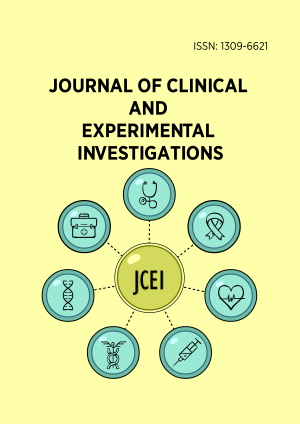Volume 3, Issue 2, June 2012
Research Article
Growth pattern in children with beta-thalassemia major and its relation with serum ferritin, IGF1 and IGFBP3
J Clin Exp Invest, Volume 3, Issue 2, June 2012, 157-163
https://doi.org/10.5799/ahinjs.01.2012.02.0135Research Article
Effects of intravenous anesthetic agents on vascular endothelium
J Clin Exp Invest, Volume 3, Issue 2, June 2012, 164-167
https://doi.org/10.5799/ahinjs.01.2012.02.0136Research Article
The Success of Cardiotocography in predicting Perinatal Outcome
J Clin Exp Invest, Volume 3, Issue 2, June 2012, 168-171
https://doi.org/10.5799/ahinjs.01.2012.02.0137Research Article
The effectiveness of treatment with enoxaparin in lichen planus
J Clin Exp Invest, Volume 3, Issue 2, June 2012, 172-173
https://doi.org/10.5799/ahinjs.01.2012.02.0138Research Article
Relationship between Oxidative Stress Markers and Cardiac Syndrome X
J Clin Exp Invest, Volume 3, Issue 2, June 2012, 174-180
https://doi.org/10.5799/ahinjs.01.2012.02.0139Research Article
Inappropriate requests of viral hepatitis serologic tests
J Clin Exp Invest, Volume 3, Issue 2, June 2012, 181-184
https://doi.org/10.5799/ahinjs.01.2012.02.0140Research Article
First trimester serum PAPP-A levels and the prediction of small-for-gestational age infants
J Clin Exp Invest, Volume 3, Issue 2, June 2012, 185-188
https://doi.org/10.5799/ahinjs.01.2012.02.0141Research Article
Diagnostic value of mycobacteriophage based fast plaque technique for early detection of pulmonary tuberculosis
J Clin Exp Invest, Volume 3, Issue 2, June 2012, 189-193
https://doi.org/10.5799/ahinjs.01.2012.02.0142Research Article
Neonatal asphyxia: A study of 210 cases
J Clin Exp Invest, Volume 3, Issue 2, June 2012, 194-198
https://doi.org/10.5799/ahinjs.01.2012.02.0143Research Article
Cardiovascular findings of children with Marfan syndrome
J Clin Exp Invest, Volume 3, Issue 2, June 2012, 199-201
https://doi.org/10.5799/ahinjs.01.2012.02.0144Research Article
Comparison of preemptive intravenous paracetamol and caudal block in terms of analgesic and hemodynamic parameters in children
J Clin Exp Invest, Volume 3, Issue 2, June 2012, 202-208
https://doi.org/10.5799/ahinjs.01.2012.02.0145Research Article
Retrospective Analysis of the patients with gynecological cancer: 11-Year Experience
J Clin Exp Invest, Volume 3, Issue 2, June 2012, 209-213
https://doi.org/10.5799/ahinjs.01.2012.02.0146Research Article
The relationship between the frequency of cervical metastases and tumor related factors in laryngeal cancer and outcome of surgical treatment in these cases
J Clin Exp Invest, Volume 3, Issue 2, June 2012, 214-222
https://doi.org/10.5799/ahinjs.01.2012.02.0147Research Article
Comparing the results of VATS pleurectomy and talc pleurodesis with small sized catheter in randomised patients with malign pleural effusion
J Clin Exp Invest, Volume 3, Issue 2, June 2012, 223-228
https://doi.org/10.5799/ahinjs.01.2012.02.0148Research Article
Relationship among Gensini score and levels of glucose and adiponectin in patients with stable angina pectoris
J Clin Exp Invest, Volume 3, Issue 2, June 2012, 229-234
https://doi.org/10.5799/ahinjs.01.2012.02.0149Research Article
Comparison of plasma homocysteine levels in patients with type 2 diabetes mellitus with normal subjects
J Clin Exp Invest, Volume 3, Issue 2, June 2012, 235-239
https://doi.org/10.5799/ahinjs.01.2012.02.0150Research Article
Isolation frequency of Mycobacterium tuberculosis in tertiary reference hospital and their susceptibility patterns against four major anti-tuberculosis drugs
J Clin Exp Invest, Volume 3, Issue 2, June 2012, 240-244
https://doi.org/10.5799/ahinjs.01.2012.02.0151Research Article
Visual and hearing disabilities and epilepsy frequency in children with cerebral palsy
J Clin Exp Invest, Volume 3, Issue 2, June 2012, 245-249
https://doi.org/10.5799/ahinjs.01.2012.02.0152Research Article
The respiratory functions and radiologic findings of the marble factory workers
J Clin Exp Invest, Volume 3, Issue 2, June 2012, 250-254
https://doi.org/10.5799/ahinjs.01.2012.02.0153Research Article
Clinical evaluation of World Health Organization criteria proposed for the diagnosis of tuberculosis in children
J Clin Exp Invest, Volume 3, Issue 2, June 2012, 255-259
https://doi.org/10.5799/ahinjs.01.2012.02.0154Research Article
The endoscopic and clinical characteristics of patients with erosive reflux disease diagnosed in gastroscopy unit of a regional hospital
J Clin Exp Invest, Volume 3, Issue 2, June 2012, 260-262
https://doi.org/10.5799/ahinjs.01.2012.02.0155Case Report
Management of forgotten ureteral double J stents: Report of two cases and review of the literature
J Clin Exp Invest, Volume 3, Issue 2, June 2012, 263-266
https://doi.org/10.5799/ahinjs.01.2012.02.0156Case Report
Avulsion fracture of the anterior inferior iliac spine in an uncommon way: A rare case
J Clin Exp Invest, Volume 3, Issue 2, June 2012, 267-269
https://doi.org/10.5799/ahinjs.01.2012.02.0157Case Report
A Neglected case admitted with paraplegia: An intradural extramedullary epidermoid cyst
J Clin Exp Invest, Volume 3, Issue 2, June 2012, 270-272
https://doi.org/10.5799/ahinjs.01.2012.02.0158Case Report
Multifocal tumorlets and a carcinoid tumor associated with bronchiectasis
J Clin Exp Invest, Volume 3, Issue 2, June 2012, 273-276
https://doi.org/10.5799/ahinjs.01.2012.02.0159Case Report
Anesthetic management of a patient with dermatomyositis
J Clin Exp Invest, Volume 3, Issue 2, June 2012, 277-279
https://doi.org/10.5799/ahinjs.01.2012.02.0160Case Report
Dental fracture and finger amputation in a child after cell phone battery explosion: A case report
J Clin Exp Invest, Volume 3, Issue 2, June 2012, 280-283
https://doi.org/10.5799/ahinjs.01.2012.02.0161Case Report
Recurrent Guillain-Barré syndrome associated with idiopathic thrombocytopenic purpura
J Clin Exp Invest, Volume 3, Issue 2, June 2012, 284-286
https://doi.org/10.5799/ahinjs.01.2012.02.0162Case Report
Descending necrotizing mediastinitis and mediastinal abscesses following odontogenic infection: A case report
J Clin Exp Invest, Volume 3, Issue 2, June 2012, 287-289
https://doi.org/10.5799/ahinjs.01.2012.02.0163Case Report
A balanced reciprocal translocation case in family with a history of recurrent abortions: 46,XY,t(4;13)(q31.3;q33)
J Clin Exp Invest, Volume 3, Issue 2, June 2012, 290-292
https://doi.org/10.5799/ahinjs.01.2012.02.0164Case Report
A snake bite case developing thrombocytopenia
J Clin Exp Invest, Volume 3, Issue 2, June 2012, 293-295
https://doi.org/10.5799/ahinjs.01.2012.02.01165Case Report
Idiopathic atrophoderma of Pasini and Pierini: A case report and review of the literature
J Clin Exp Invest, Volume 3, Issue 2, June 2012, 296-299
https://doi.org/10.5799/ahinjs.01.2012.02.0166Case Report
'Foetus' in Heart: A case of myxoma
J Clin Exp Invest, Volume 3, Issue 2, June 2012, 300-302
https://doi.org/10.5799/ahinjs.01.2012.02.0167Review
A Genetical approach to deep venous thrombosis
J Clin Exp Invest, Volume 3, Issue 2, June 2012, 303-306
https://doi.org/10.5799/ahinjs.01.2012.02.0168
